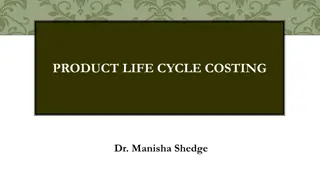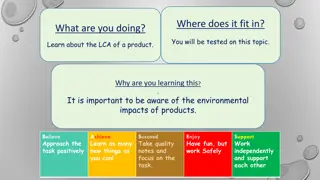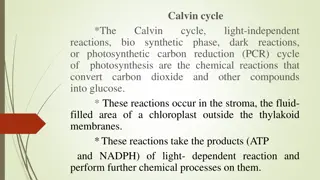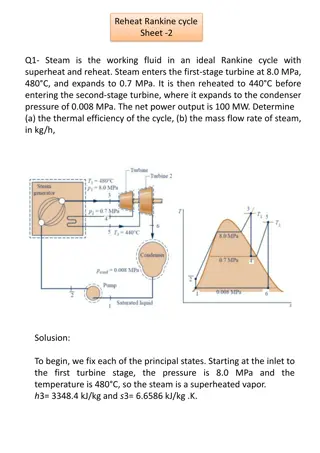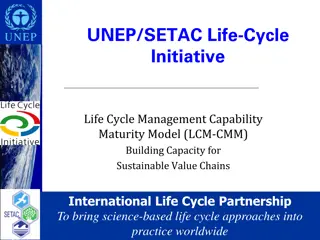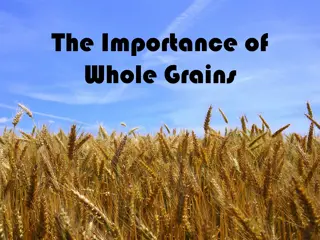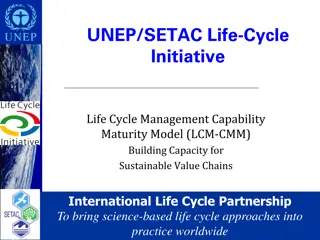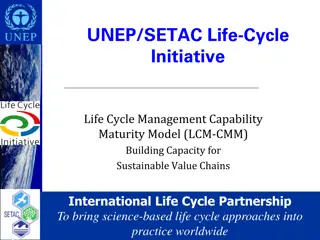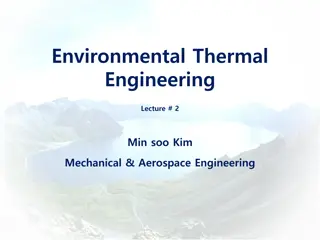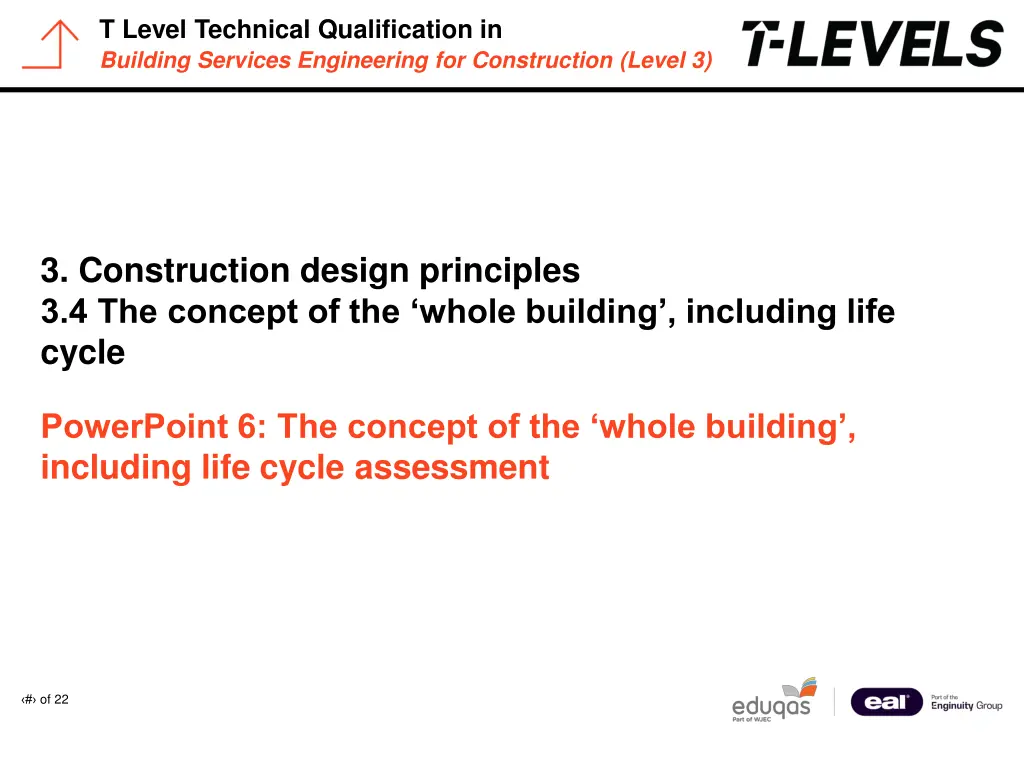
Building Services Engineering Sustainability & Life Cycle Assessment
Learn about the concepts of sustainability in building projects, including the use of renewable resources, energy efficiency, and the BREEAM standards. Explore the importance of considering the whole building life cycle, from construction to demolition and repurposing, for a more environmentally-friendly approach in construction engineering. Discover how repurposing existing buildings can give them a new lease of life in modern contexts.
Download Presentation

Please find below an Image/Link to download the presentation.
The content on the website is provided AS IS for your information and personal use only. It may not be sold, licensed, or shared on other websites without obtaining consent from the author. If you encounter any issues during the download, it is possible that the publisher has removed the file from their server.
You are allowed to download the files provided on this website for personal or commercial use, subject to the condition that they are used lawfully. All files are the property of their respective owners.
The content on the website is provided AS IS for your information and personal use only. It may not be sold, licensed, or shared on other websites without obtaining consent from the author.
E N D
Presentation Transcript
T Level Technical Qualification in Building Services Engineering for Construction (Level 3) PowerPoint presentation 3. Construction design principles 3.4 The concept of the whole building , including life cycle PowerPoint 6: The concept of the whole building , including life cycle assessment # of 22
T Level Technical Qualification in Building Services Engineering for Construction (Level 3) Sustainability and BREEAM definitions Sustainability: when planning and delivering a construction project is achieved by using renewable and recyclable resources, reducing energy consumption and waste, creating a healthy and environmentally friendly environment, and by protecting the natural environment. Sustainability is also achieved by using locally sourced materials, resource protection, re- use, and refurbishment of materials. BREEAM: the Building Research Establishment (BRE) Environmental Assessment Method. It sets best practice standards for the environmental performance of buildings through design, specification, construction and operation. # of 22
T Level Technical Qualification in Building Services Engineering for Construction (Level 3) The concept of the whole building When designing a new structure, it is important to look beyond the construction project to the full life cycle of the whole building. Construction is just one stage of this cycle. Disposing or recycling materials Raw materials Building materials Occupation Construction Demolition # of 22
T Level Technical Qualification in Building Services Engineering for Construction (Level 3) Life cycle assessment This covers all stages of a construction project. The assessment includes extraction of raw materials used to manufacture building materials/components; transportation of goods; the construction process; maintenance and refurbishment; the demolition process (when a building is no longer fit for purpose); recycling/repurposing as much as of the building s material as possible back into raw materials, saving finite natural resources. # of 22
T Level Technical Qualification in Building Services Engineering for Construction (Level 3) Repurposing existing buildings Buildings reach the end of their natural life cycles for many reasons e.g., changes in lifestyle or technology making traditional methods/ buildings obsolete. But they can also have a new lease of life through repurposing e.g., warehousing converted into apartments, country houses into leisure centres/spa hotels, and barns into accommodation/holiday lets. This reduces the impact on the use of resources and extends the life cycle assessment of a building. # of 22
T Level Technical Qualification in Building Services Engineering for Construction (Level 3) Materials recycling, repurposing and re-using Recycling building materials whenever possible reduces the impact on natural resources. Fewer trees cut down and fewer base materials quarried/mined reduces carbon footprint because processing, manufacturing, shipping and transport are all kept to a minimum. Many items can be upcycled or repurposed to bring a designer look to a property. Many materials can be reused to recreate a traditional look. During heritage work or repairs the use of recycled bricks and timber might be the only option that will produce the finish required for the property. # of 22
T Level Technical Qualification in Building Services Engineering for Construction (Level 3) Materials architectural salvage This is the removal of decorative items from a property. It can include doors, windows, panelling, mouldings, ironmongery, fireplaces, lintels, sills, stone flags, bricks, chimney pots, tiles/slates and other sought-after items. There is a growing market for repairing heritage properties and developers looking to add period charm to, e.g., a pub, restaurant or hotel. # of 22
T Level Technical Qualification in Building Services Engineering for Construction (Level 3) Materials aggregates Any masonry product that can not be recycled can be crushed into aggregate, which is then used in a range of products. Stone, slate, marble, granite and so on can be used for decorative aggregates. Bricks and concrete can be crushed and used as hard core or aggregate for concrete. Type 1 Concrete is produced from crushed aggregate recycling waste materials from construction/demolition projects. It is perfect for using in trench fills, backfills, oversite fills and as a granular sub-base. # of 22
T Level Technical Qualification in Building Services Engineering for Construction (Level 3) Metals Because ferrous and non-ferrous metals can be re-melted and reformed into new products almost indefinably, scrap and reclaimed metal are ideal materials for recycling reducing both the depletion of natural resources and the carbon footprint from mining ore and smelting new metals. Percentage of metal used from a recycled source The amount of energy saved (%) using recycled metals compared to virgin ore: 80% 60% 40% steel 62 74 copper 87 zinc 63 lead 60 20% 0% Lead Zinc Copper Aluminium Steel Percentage of metal used from a recycled source # of 22
T Level Technical Qualification in Building Services Engineering for Construction (Level 3) Material waste landfill Land fill is discouraged as it pollutes the ground, wastes valuable resources and can produce dangerous gases. The UK government has implemented a landfill tax to offset the cost of landfill for inspection programmes or long-term mitigation of environmental impacts relating to disposal and to encourage other methods of disposal due to the cost of landfill. There are two rates: the lower rate for inert or inactive waste; and the higher rate for all other landfill materials. Rate from 1 April 2021 Rate from 1 April 2010 Rate from 1October 1996 Standard rate 96.70/tonne 48/tonne 7/tonne Lower rate 3.10/tonne 2.50/tonne 2/tonne # of 22
T Level Technical Qualification in Building Services Engineering for Construction (Level 3) Material waste recycling Wood is used to fire biomass boilers or processed into animal bedding after it has been shredded and screened for foreign particles. Large sections are often reused. If mixed with organic material in land fill, plasterboard gives off an odorous and toxic gas called hydrogen sulfide. Plasterboard can instead be recycled to make new sheets of plasterboard. Metal requires very little energy to recycle in comparison to mining ore, refining and smelting it into a pure metal. Therefore, it is cost effective to recycle. # of 22
T Level Technical Qualification in Building Services Engineering for Construction (Level 3) Environmental legislation some important acts There is a great deal of legislation covering the environment: Control of Pollution Act covers air, noise, water, atmospheric pollution and waste on land Environmental Protection Act controls waste management and emissions in the environment within the UK Wildlife and Countryside Act gives protection to native species and their habitats; controls the release of non-native species and enhances the protection of SSSIs. Other legislation includes the Weed Act, Protection of Badgers Act and the Hunting Act. # of 22
T Level Technical Qualification in Building Services Engineering for Construction (Level 3) Environmental laws conservation Planning (listed buildings and conservation areas) Act: to protect listed buildings and conservation areas within the UK. Ancient Monuments and Archaeological Areas Act: to protect any building or structure that has been classed as a monument. National Parks and Access to the Countryside Act: to control the creation of national parks and areas of outstanding beauty, including public rights of way. It is often difficult to obtain planning permissions within these areas and, if granted, will have many stipulations attached. # of 22
T Level Technical Qualification in Building Services Engineering for Construction (Level 3) Environmental laws climate change Climate Change Act: introduced in 2008 and designed to reduce CO2 emissions in the UK by at least 80% by 2050. This target was updated in 2019 with a new target requiring the UK to bring all greenhouse gas emissions to net zero by 2050. Planning and Energy Act: introduced in 2008 to allow planning authorities to impose requirements on local planning applications regarding energy use and efficiency. Energy Act: requires energy providers to meet certain energy efficiency requirements when providing energy to consumers e.g. reducing carbon emissions and home heating costs. # of 22
T Level Technical Qualification in Building Services Engineering for Construction (Level 3) Any questions? # of 22

